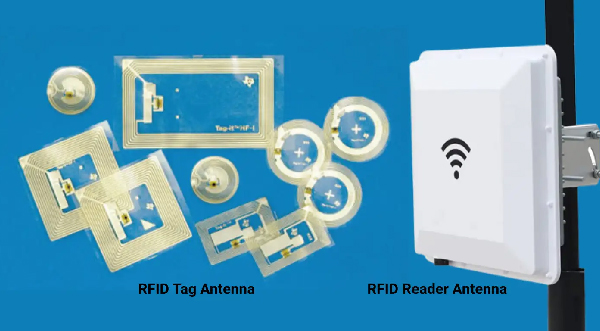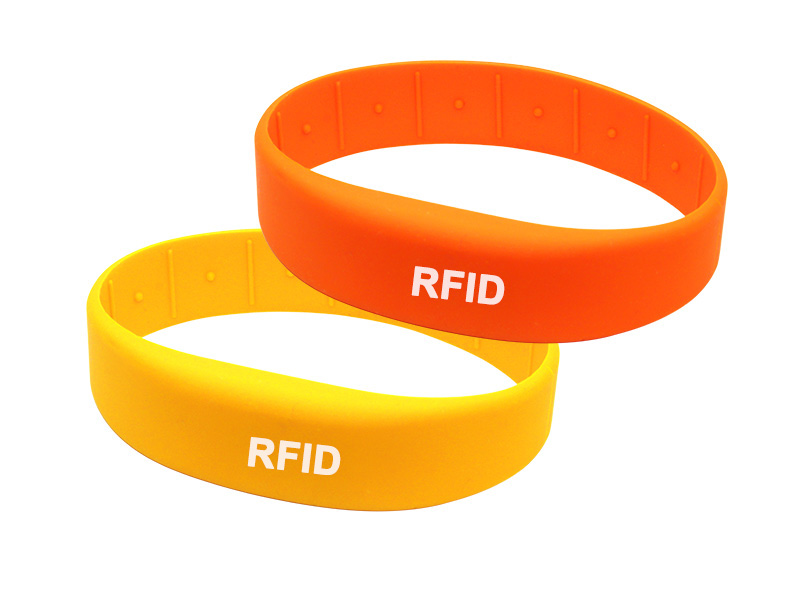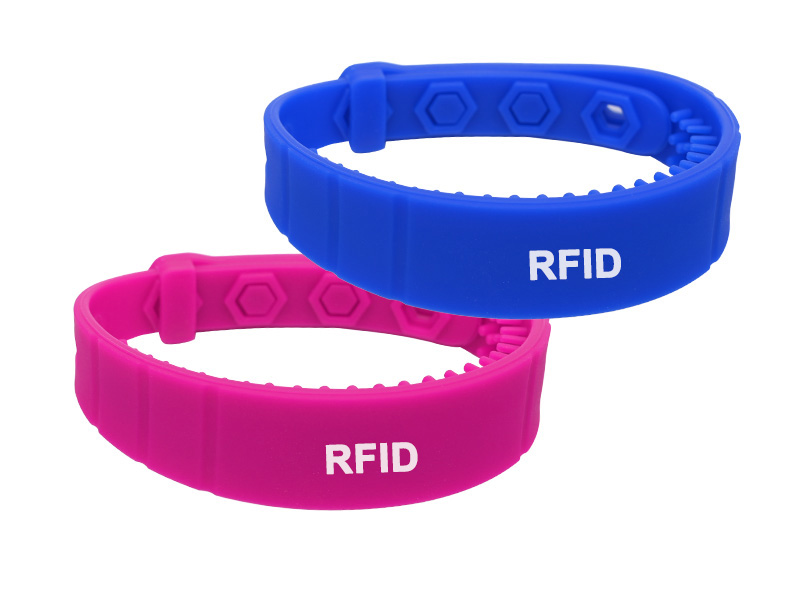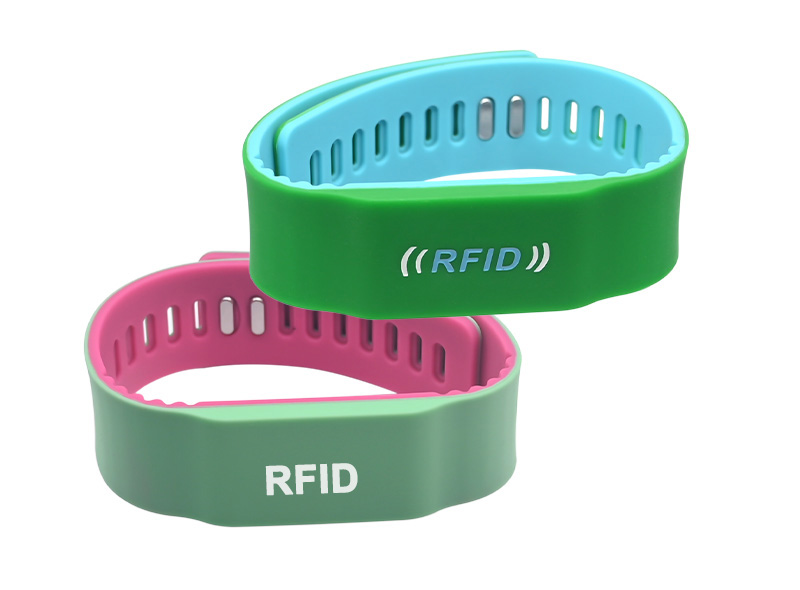Principles of RFID Technology and RFID Tag Antennas
 1 Introduction
1 Introduction
Radio frequency identification (RFID) is a non-contact automatic identification technology that uses radio frequency technology. It has advantages such as fast transmission speed, anti-collision, large-scale reading, and motion process reading. Therefore, RFID technology has significant application potential in various fields such as logistics and supply chain management, production management and control, anti-counterfeiting and security control, and traffic management and control. At present, the working frequency bands of radio frequency identification technology include low frequency, high frequency, ultra-high frequency, and microwave band, among which high frequency and ultra-high frequency are the most widely used.
Principles of RFID Technology
The RFID system mainly consists of a reader/writer, a responder (RFID electronic tag), and a backend computer. The reader/writer realizes data reading, writing, and storage of the tag, which is composed of a control unit, a high-frequency communication module, and an antenna. The tag is mainly composed of an integrated circuit chip and an external antenna. The circuit chip usually includes RF front-end, logic control, memory, and other circuits. Tags can be divided into active (acTIve) tags, semi-active (semi-active) tags, and passive tags according to the power supply principle. Passive tags are favored due to their low cost and small size.
The basic working principle of RFID system is: after the electronic tag enters the reader/writer to emit RF field, the induced current obtained by the antenna is used as the power supply of the chip through the boost circuit. At the same time, the induced current with information is converted into a digital signal through the RF front-end circuit and sent to the logic control circuit for processing. The information that needs to be replied to is sent from the tag memory, sent back to the RF front-end circuit through the logic control circuit, and finally sent back to the reader/writer through the antenna.
Antennas in RFID systems
From the perspective of RFID technology principles, the key to the performance of RFID electronic tags lies in the characteristics and performance of the RFID electronic tag antenna. The antenna plays a key role in the data communication process between electronic tags and readers. On the one hand, the chip startup circuit of the tag starts working, and sufficient energy needs to be obtained from the electromagnetic field generated by the reader through the antenna; On the other hand, the antenna determines the communication channel and communication method between the tag and the reader/writer. Therefore, the research on antennas, especially the internal antennas of tags, has become a focus.
3.1 Types of RFID system antennas
According to the power supply method of RFID electronic tag chips, RFID electronic tag antennas can be divided into two types: active antennas and passive antennas. The performance requirements for active antennas are lower than those for passive antennas, but their performance is greatly affected by battery life: passive antennas can overcome the limitations of active antennas due to battery limitations, but have high performance requirements for antennas. At present, the research focus of RFID antennas is on passive antennas. From the working frequency band of RFID systems, in the LF and HF bands (such as 6.78MHz and 13.56MHz), the transmission of electromagnetic energy is completed in the induction field area (similar to a stable field) of RFID systems, also known as induction coupling systems; In the UHF band (such as 915MHz, 2400Mttz) Z, the transmission of electromagnetic energy is completed in the far-field region (radiation field), also known as microwave radiation system. Due to the different energy generation and transmission methods of the two systems, the corresponding RFID electronic tag antennas and front-end parts have their own particularities. Therefore, tag antennas are divided into near-field induction coil antennas and far-field radiation antennas. The induction coupling system uses a near-field induction coil antenna, which is composed of multiple turns of inductive coils. The inductive coils and capacitors connected in parallel form a parallel resonant circuit to couple the maximum RF energy; The types of far-field radiation antennas used in microwave radiation systems are mainly dipole antennas and slot antennas. far-field radiation antennas are usually resonant and typically take half a wavelength. The shape and size of an antenna determine its ability to capture frequency ranges and other performance indicators. The higher the frequency, the more sensitive the antenna is, and the less area it occupies. Higher operating frequencies can result in smaller tag sizes, and compared to near-field induction antennas, far-field radiation antennas have higher radiation efficiency.
3.2 Design Requirements for RFID Electronic Tag Antennas
The design requirements for RFID electronic tag antennas mainly include: the physical size of the antenna is small enough to meet the needs of tag miniaturization; Having directionality with omnidirectional or hemispherical coverage; A chip with high gain that can provide the maximum signal to the tag; Good impedance matching, regardless of the direction of the tag, the polarization of the tag antenna can match the signal of the reader/writer; Has robustness and low cost. When choosing an antenna, the main considerations are: the type of antenna, the impedance of the antenna, the RF performance applied to the item, and the RF performance when other items surround the tagged item.
4 Categories and Research Status of RFID Electronic Tag Antennas
Electronic tag antennas are mainly divided into three categories: coil type, dipole type, and slot (including microstrip patch) type. Coil antenna is a type of antenna that coils metal wires into a flat surface or wraps them around a magnetic core; A dipole antenna consists of two straight wires of equal thickness and length arranged in a straight line, with signals fed from the two endpoints in the middle. The length of the antenna determines the frequency range; A slot antenna is composed of grooves cut from a metal surface, where a microstrip patch antenna consists of a circuit board with a rectangular end, and the length and width of the rectangle determine the frequency range.
RFID antennas for low to medium frequency close range application systems with a recognition distance of less than 1 meter generally use coil type antennas with simple processes and low costs; Long distance application systems in high-frequency or microwave frequency bands above 1I1 require the use of dipole and slot antennas.
4.1 Coil antenna
When the tag coil antenna enters the alternating magnetic field generated by the reader/writer, the interaction between the tag antenna and the reader/writer antenna is similar to that of a transformer. The coils of both are equivalent to the primary and secondary coils of a transformer.
The carrier frequency used for bidirectional communication between tags and readers is when the tag antenna coil is required to have a small shape, i.e. a small area, and a certain working distance. The mutual inductance between the RFID tag and the reader antenna coil cannot meet the actual needs. High permeability ferrite material can be inserted inside the tag antenna coil to increase the mutual inductance and compensate for the problem of small coil cross-section. Currently, the implementation technology of coil type antennas is mature and widely used in RFID systems such as identity recognition and cargo tags. However, for RFID applications with high frequency, large information content, uncertain working distance and direction, it is difficult to achieve corresponding performance indicators using coil type antennas.
4.2 Dipole antenna
Dipole antennas have the advantages of good radiation capability, simple structure, and high efficiency, and can be designed as RFID systems suitable for all-round communication. They are widely used in the design of RFID electronic tag antennas, especially in long-distance RFID systems.
The biggest problem with traditional half wave dipole antennas is the impact on tag size, such as the 915MHz half wave dipole. Research has shown that terminated, tilted, and folded dipole antennas can achieve the desired input impedance by selecting appropriate geometric parameters. They have the advantages of high gain, wide frequency coverage, and low noise, and have excellent performance. Compared with traditional half wave dipole antennas, they are much smaller in size. If combined with brazed electrical terminals and unbalanced transformers, they can also maximize gain, impedance matching, and bandwidth. Given that increasing the number of antenna bends is beneficial for reducing antenna size without reducing antenna efficiency, how to perform "bending" in limited space, and what are the specific parameters of "bending" that affect the resonant frequency and input impedance of the tag antenna? How to achieve the highest RF efficiency through "bending"?
We know. Objects with fractal structures generally have the characteristics of proportional self similarity and spatial filling, which can be applied to antenna design to achieve multi band characteristics and size reduction of antennas. A large amount of research has been conducted on antennas with fractal structures both domestically and internationally, confirming that fractal structured antennas have good size reduction characteristics and can significantly improve antenna efficiency in limited spaces.
By using Hilbert fractal transform at different positions and dimensions of the half wave oscillator and simulating the Hilbert tag antenna using the method of moments, the resonance frequency and input impedance of the tag antenna can be obtained as a function of fractal dimension and order. The antenna gain and efficiency in the results can be analyzed to determine which dimension and order of the tag antenna best meets the design requirements of the actual tag antenna. Further, a physical antenna can be made and the RF recognition distance can be tested. This is a commonly used research method.
4.3 Gap (including microstrip patch) antenna
Slot antennas have the characteristics of low profile, light weight, simple processing, easy conformity with objects, mass production, diverse electrical properties, and the integration of broadband and active devices and circuits into a unified component. They are suitable for large-scale production and can simplify the production and debugging of the entire machine, thereby greatly reducing costs.
Microstrip patch antenna is composed of radiating patch conductors attached to a dielectric substrate with a metal substrate. Based on the radiation characteristics of the antenna, patch conductors can be designed in various shapes. Widely used in low profile structures with frequencies above 100MHz, it usually consists of a thin layer of dielectric (called substrate) surface placed on a ground plane with a rectangular or square metal patch. The patch can be manufactured using photolithography technology, making it low-cost and easy to mass produce.
As mentioned earlier, bent antennas are beneficial for reducing the physical size of tag antennas and meeting the design requirements for tag miniaturization. For slotted antennas, the concept of bending can also be utilized. In fact, the bent slot antenna is suitable for RFID tags in the high-frequency microwave range, which can effectively reduce the antenna size and have excellent performance. Has broad market prospects. The research method is similar to that of bent dipole antennas, using the method of moments to study the influence of the number, height, position, width, and size of the slot antenna on the resonant characteristics of rectangular antennas.
The bent slot antenna has a flat sheet size of LxW, a slot bending width and height of s and h respectively, and a slot distance from the center of the feeding point of. The following discusses the effects of these parameter changes on the resonance characteristics, reflection coefficient, antenna efficiency, and other aspects of the slot antenna.
Based on the influence of bending parameters on the performance of slot antennas, slot antennas for UHF RFID tags can be designed according to actual needs, and specific physical antennas can be made. It can be expected that bent slot antennas will be a promising development direction in the field of UHF electronic tag antenna design.
5 Hot Issues of RFID Electronic Tag Antennas
In the design of RFID electronic tag antennas, in addition to the highly valued issue of reducing physical size, further improving the bandwidth and gain characteristics of miniaturized antennas to expand their practical application range, analyzing the cross polarization characteristics of miniaturized antennas to clarify their polarization purity is also an important research direction. In addition, the design of composite antennas covering various frequencies, multi tag antenna optimization distribution technology, reader intelligent beam scanning antenna array technology, design simulation software and platforms, tag antenna and attachment medium matching technology, consistency anti-interference and safety reliability technology are all worth continuing to study.
Among them, on-chip antenna technology is a hot research topic in recent years. The continuous expansion of RFID technology application fields has raised the requirements for miniaturization, lightweighting, multifunctionality, low power consumption, and low cost of RFID electronic tags. However, current RFID electronic tags still use off chip independent antennas, which have the advantages of high antenna Q (quality factor) value, easy manufacturing, and moderate cost. The disadvantages are large size, easy breakage, and inability to perform tasks such as anti-counterfeiting or implanting biological tags into animal bodies. If the antenna can be integrated onto the tag chip and work without any external components, it will make the entire tag smaller and more convenient to use, which has sparked research on on-chip antenna technology.
Integrating the antenna onto the chip not only simplifies the original electronic tag production process, reduces costs, but also improves reliability. The on-chip antenna, as an energy receiver and signal sensor, determines the performance of the entire system, and its basic starting point is to use Faraday's electromagnetic induction principle. Convert the magnetic field energy from external changes into on-chip power supply voltage, which serves as the working power source for the entire chip. At the same time, use the changes in on-chip current or voltage caused by electromagnetic field changes to identify the received signal. By changing the external magnetic field caused by its own output impedance, the signal is transmitted to the receiving end. So far, on-chip antennas implemented on standard CMOS processes still use silicon-based integrated spiral inductors as the main structure.







 1 Introduction
1 Introduction


